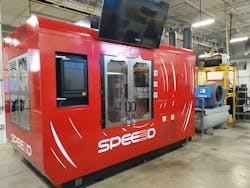Missouri S&T Invests in Advanced Manufacturing with a New Metal 3D Printer
To support Missouri manufacturers and enhance their competitive edge, the Kummer Institute Center for Advanced Manufacturing at Missouri University of Science and Technology (S&T) has made a significant investment in technology. The recent purchase of a large-format metal 3D printer from SPEE3D is a crucial step toward incorporating additive manufacturing into the state’s industrial sector.
The decision to acquire the WarpSPEE3D printer was influenced by feedback from manufacturers who have encountered difficulties in the traditional supply chain for manufactured parts. Irregularities in the supply chain have prompted the need for alternative production methods, and additive manufacturing has emerged as a viable solution. With additive manufacturing, S&T aims to gain knowledge and expertise that can aid manufacturers in transitioning to new production processes, including considerations like geometry constraints, material properties and heat treatment requirements.
READ MORE: When to Invest in 3D Printing: Timing is Everything
Dr. Richard Billo, director of the Center for Advanced Manufacturing, emphasizes the importance of additive manufacturing becoming the new norm for Missouri manufacturers to thrive globally. “For Missouri manufacturers to succeed on the global stage, additive manufacturing must become the new normal,” he says, noting that the upcoming Missouri Protoplex, an advanced manufacturing research and development facility set to open in fall 2025, is where the new printer and other equipment will be housed.
The WarpSPEE3D printer creates parts by rapidly projecting metallic particles onto a build platform using supersonic speeds, facilitated by a robot controlling particle projection direction.
Apart from supporting manufacturers’ projects, working with the WarpSPEE3D printer provides undergraduate and graduate students at S&T with valuable experience and understanding of challenges faced by manufacturers. Students can program the printer, document operating procedures, design CAD models, perform testing and develop maintenance plans. This holistic approach to workforce development aims to equip students with hands-on experience in product development and manufacturing methods.
Bridging the Gap as Collaborators
The printer acquisition aligns with the goals of a $300 million gift from June and Fred Kummer to S&T in 2020. The gift’s mandate is to bridge the gap between academic research and industry needs, ensuring Missouri manufacturers remain competitive in a technologically driven marketplace. Billo emphasizes the importance of workforce development beyond machinery operation, stating that knowledge of additive manufacturing is critical at all levels, from classroom to executive suites. S&T is actively developing programs to spark interest in this technology among K-12 students in the region.
Billo emphasizes the significance of collaboration and developing standards in the additive manufacturing industry. By investing in equipment from collaborators like SPEE3D, S&T aims to nurture an evolving industry that prioritizes common goals.
Driven by a commitment to forge relationships across the supply chain, contribute to industry standards and collaborate with other educational institutions, S&T aims for additive manufacturing to reach the same level of maturity as established methods like forging and casting.
READ MORE: The Need for Speed: 3D-Printer Manufacturers Eye Mass Production
“For additive manufacturing to evolve to the level of forging and casting, it’s critical for everyone across the industry, from the manufacturers themselves to the colleges and universities and tech schools to companies like SPEE3D that will develop the equipment, to collaborate on developing standards,” Billo says. “Additive manufacturing has made significant advancements relatively quickly, but like many technology-driven industries, it’s in its infancy.”
As additive manufacturing continues to advance, the university’s investment in equipment and research will play a pivotal role in supporting Missouri manufacturers, enabling them to embrace innovative technologies and maintain a competitive edge in the global marketplace.
About the Author
Sharon Spielman
Technical Editor, Machine Design
As Machine Design’s technical editor, Sharon Spielman produces content for the brand’s focus audience—design and multidisciplinary engineers. Her beat includes 3D printing/CAD; mechanical and motion systems, with an emphasis on pneumatics and linear motion; automation; robotics; and CNC machining.
Spielman has more than three decades of experience as a writer and editor for a range of B2B brands, including those that cover machine design; electrical design and manufacturing; interconnection technology; food and beverage manufacturing; process heating and cooling; finishing; and package converting.
Email: [email protected]
LinkedIn: @sharonspielman
Facebook: Machine Design
YouTube: @MachineDesign-EBM


